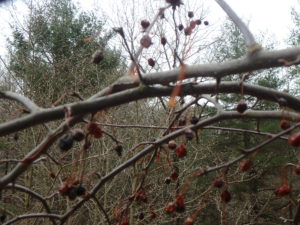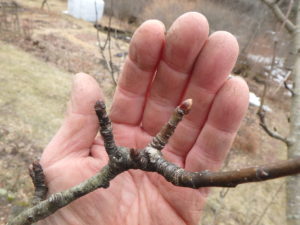It’s Time to Prune Your Fruit Trees
Posted on Tuesday, March 24, 2020 · Leave a Comment
We are lucky this March: no deep snow to keep us from approaching our fruit trees, ladder and clippers in hand. Some years we still have thigh-deep snow in March, which is the traditional time to prune our apples, pears, peaches and more.
There is nothing magical about March as a time for pruning your fruit trees: you can prune anytime of the year without harming your trees. After the buds open up in late spring they are more easily knocked off, but that is not usually an issue for home gardeners – we have more fruit buds than needed. I think March is the time when, traditionally, farmers were less busy – so they pruned apples.
I recently took a good look at the fruit trees on my property. I have 2 pear trees and numerous apples, both crabapples and standard apples. Since I prune yearly, my trees are in pretty good shape.

Water sprouts need to be removed yearly
The key to good tree health and production is to allow every leaf on the trees to get sunshine. Shaded leaves don’t do much to produce food for roots or fruit, and those leaves also shade others. I like to say a robin should be able to fly through a fruit tree without getting hurt.
It’s important to recognize the basic nature of each tree. Most pears, for example want to grow tall and lean. However, picking pears on a tall tree is difficult, and you can reduce the height of a pear without damaging it. I have been known to lop off the top 10 feet of a pear tree without adverse results. Yes, the tree did try to send up lots of suckers, or vertical shoots, to replace the portion I removed, but they are easy to snip off each year.
How much can you prune from a tree each year? In the past experts said, up to one third of a tree. Nowadays, experts advise removing not more than a quarter of a tree. How do you calculate that? Leave your trimmings in a pile on the ground as you work. Then you can see how much you’ve taken. Try to calculate the percentage of leaves taken off. A one-inch diameter branch that is 6 feet long has lots of leaves, but a 6-inch diameter branch may have few.
Dead wood does not count in the calculation of how much you can remove. Even now, before leaf-out, you can recognize a dead branch easily: the bark is dry and flaky. If you take your thumb nail and scratch a small twig on a branch, it should show green. If not, it is dead and should be removed.
It’s important to know where to make your cuts. You should leave the “branch collar” on the tree. That’s the swollen and wrinkly part of a branch right where it attaches to the tree or a larger branch. It’s where the tree heals itself. Don’t cut flush to the trunk or a larger branch.

Crossing or rubbing branches need to be removed
Here is what you should remove: 1. Branches that are headed back into the tree or going through the middle of the tree. 2. Branches that are damaged, cracked or split. 3. Branches that are competing for light with another branch – either below it or above it. 4. If two branches that are rubbing, remove one. 5. Those pencil-thin “water sprouts” that shoot straight up.
A few words about water sprouts. These are numerous on some fruit trees, less so on others. If you have a nice open tree that gets good sunshine on all its leaves, the tree is less likely to produce many of those pesky sprouts. They are often a stress response – they may be indicating the roots are not getting enough food, so the tree responds by producing more leaves. So leave a few sprouts if you have many, but also work on training branches to reach out, away from the center of the tree to get more sun.

Fruit Spurs are Short
Where is fruit produced? Most fruit trees produce “fruit spurs” that blossom and also produce leaves. These spurs range in length from 2 inches to 6 inches. For apples, a fruit spur will not produce fruit the first year it grows, only in subsequent years. Most spurs are produced on branches that are on branches that are 30- to 60-degrees from vertical. So those vertical water sprouts will not produce fruit.
You can change the angle of a branch by tying it down, spreading it with a piece of wood or even weighing down a branch with a jar of water. Hang the jar (or 1-quart plastic milk jug) and add water until the mostly vertical branch bends down to a better angle. Remove the jar in mid-June and it should stay in place.
Some fruit trees produce lots of shoots around the base of the tree. Those are an unsightly nuisance, and should be cut right to the ground. Since most fruit trees are grafted to root stock, those shoots are not the same variety as the tree itself.
Later on, if you get a huge number of blossoms, you will need to thin out some of the fruit in early summer. If you don’t do that, your fruits will be small – no matter how nicely pruned your tree might be.
So get out your pruners and saw, and spend a sunny afternoon working on your fruit trees. Not only will your trees do better, you will, too.





